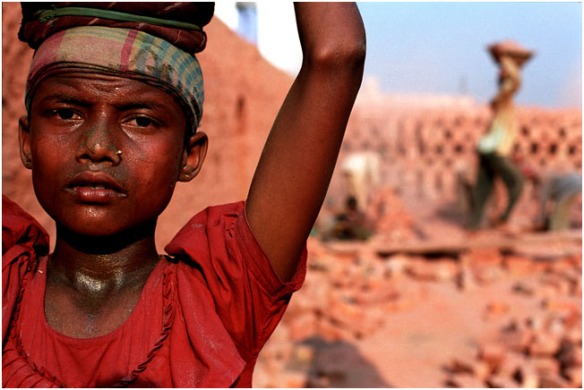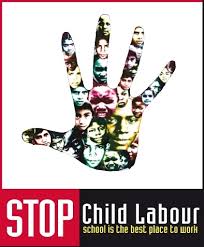We have already known, from the last articles about the 12 years oldchildren, the golden age of a child’s character development is in the range of age 10 to 16 years old. At that time, the children perception about living is growing up creating their mindsets about how they will run their life, about how their future will be. Thus, children in this age should be in a good education environment. They go to school to get proper education, get the health care, and parents who control their social living. That is the ideal condition expected most of the people in the world. But that is not the actual condition. There are so many phenomena which threat children of being how children supposed to be. One of them is the child labour.
According to the International Labour Organization of United Nation, child labour is labour activities performed by children under their minimum age specified for that kind of work and also may jeopardize the physical, mental, and moral well-being of the children because of its natures or condition carried out by the work. The minimum age is usually determined by country legislation but commonly, the minimum age for a child to be employed is 15 to 17 years old. The kind of work which tends to jeopardize the physical, mental, and moral well-being of the children is called hazardous work.
Although not every work done by a child is bad, most child labour case bring negative effects to the children because most of the children come by coercion and intimidation from neither the master nor the parents. Another, the jobs offered for the children is not really a good job and, what I called; job that destroying their joyful time; such as prostitutions, drugs or guns dealers, street singer, or housemaids.
There are nearly 200 million children in age 5 to 14 from all around the world which involve in child labour, including 110 million from Asia and 10%, almost 20 million, of the young kids are in hazardous work. By percentage, Sub Saharan-Africa is the region with the highest rate of child labour. More than 25% of all children there, in the same range of age, must have worked. In numbers, India has the largest child labour force in the world by more than 35 million of the children are in work. By the sector of job, agricultural is the most likely sector for child labour to be found, with 63.5% of the rate. The second is in small industries (18%), then service (17%), and others sector (1.5%). For the industries sector, child labour case often found in textile and clothing industries. Other industries are cigarette, metal, lumber, and food. In India, there are approximately 25,000 children forced to work on leather shoes manufacturing without any wage. In Egypt, which is one of the most child labour cases found in Africa, the children have to work 29.99 hours per week. This value is longer than the average work hours of the adults which are about 27.46 hours per week. Even in China, some of the children in age of 10 to 13 have to work more than 18 hours a day and only paid 0,44$.
There are many causes that trigger the child labour. But based on my analysis, there are two main causes of most child labour case. The first is there are companies looking for more profit and use children as their worker because children are cheap. The companies threat the children to work without any pay and the children have no power to fight. Other cause is parents who sent their children to work. Parent whose family is in poverty used to sent their children to work to support the family needs. Often cases found that parents force their children to work to pay off the family debt to the work master. A survey held by International Labour Organization found that 50% child workers in India are sent by their parents and 25% of them had not completed the primary school and 83% of them said that they want to go to school.
Those facts are enough for us to say that most child workers are come by coercion. This, of course, gives negative effects for the children neither psychologically nor physically. We can see even only in India there are about 500,000 of child workers had lost their desire to study in school. Others bad psychological effect is the coercion will destroy their mental. Many children who had been “rescued” from the force of work became fear of stranger. They cannot handle the trauma of being tormented. The others are even worse. They become bad children who always disobey the rules, join the gangster, using drugs, and many more. This could happen if the work environment doesn’t force the child to work directly but they persuade the children by “pleasure” them. In china, there is a cigarette factory, which ask the children to smoke the cigarette every lunch time in order to make them addicted and want to work in that factory without any coercion. Imagine later in the future, these children could be the drugs user.
Remember, the child workers use to be in range of age 10 to 16 which is, as I write earlier, the golden phase of a psychological development of a child. By put them in such environment, their character will be formed as what their environment is. If we want to look closer, we can see the fear and sadness in every street beggar child.
Child labour also might harm the children’s health. Many children have to work in industries which involve many kinds of chemicals and without proper safety kit. A survey in India found almost 600,000 children work in silk factories and there are 1,700 over 2,000 child workers in silk factories had a respiratory disease. Another in India, there is a phrase that describes a health issue in shoe factories called “the shoemaker paralysis”. A medical survey found that most children in shoemaker industries had numbers of health compilation such as cancer, skin infection, lungs infection, hand paralysis, mental disorder, and many more. These diseases are caused by the chemical found in the glue which has the neurotoxin properties. The children in shoemaker factories use to work in gluing sector and they work without masker or any other safety kit. There are many others physical harms for the child workers such as the metal or glass industries which the children have to work in furnace with 2000 oF of temperature, in mining industries which the children may work in the high cliff or in the river.
The child labour is serious and a complex problem. Many actions should be taken to solve this complexity. This problem needs attention and participation from many segments of people. Therefore, we must not be a government to do a solution. We must not join a NGO to do an action. We can start from the small things, let’s look around us.
Sources:
- http://filipspagnoli.wordpress.com/stats-on-human-rights/statistics-on-labor-conditions/statistics-on-child-labor/
- http://ilo.org/dyn/clsurvey/lfsurvey.home
- http://productsofslavery.org/
- http://ucw-project.org/Pages/ChildLabIndicator.aspx
- International Labour Organization and Egyptian Central Agency for Public Mobilization and Statistic. 2012. Working Children in Egypt: Result of the 2010 Child Labour Survey. Egypt.
- Save The Children. 2008. Spotlight of Child Labour in India. England
Photos:


